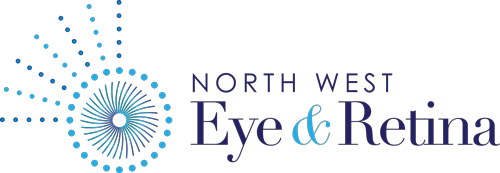Age-related macular degeneration
What is AMD?
Age-related macular degeneration (AMD) is a chronic disease that affects the macula area of the retina and can lead to the progressive loss of central vision. The condition is painless and usually affects people over 50 years of age. In some people, AMD may progress slowly and its effects on vision may not be noticed, while in others it may progress faster and lead to rapid vision loss.

Types of age-related macular degeneration
AMD is classified into stages — Early, Intermediate and Late.
Early and Intermediate AMD
Are caused by the accumulation of waste products (drusen) under the retina. Early stages of macular degeneration usually have little impact on vision, while intermediate stages may cause subtle changes to central vision, such as distortion or blurring.
Occurs when the retinal cells (photoreceptors) gradually die, leading to loss of central vision. Some people with dry AMD can also develop wet AMD.
Wet (neovascular) AMD
Occurs when abnormal, fragile blood vessels grow under the retina and leak fluid or blood. This can damage the macular photoreceptors that detect light and leads to acute loss of central vision.
How is AMD treated?
The treatment of AMD depends on its subtype and the severity of disease. For wet AMD, early and prompt treatment can help prevent vision loss and maintain your best vision for as long as possible. For dry AMD, while there is currently no cure, dietary modification and the use of specific nutritional supplements may be of benefit.
Late stage AMD
Can threaten your vision and is divided into two categories — dry and wet AMD.
Recommended treatments
In wet AMD, abnormal blood vessels grow and leak fluid under the retina. This is primarily caused by a protein called Vascular Endothelial Growth Factor (VEGF). Standard treatment for wet AMD involves an injection of anti-VEGF medication into the eye.
Most people receive eye injections regularly and they often need to be continued over an extended period of time. Treatment recommendations however are individual and will be discussed with you at your consultation.
How long does it take to recover from AMD treatment?
Most people are able resume their normal activities within a few hours of their AMD treatment. However, you are advised not to drive on the day of your eye procedure, and you should avoid getting water into your eye for the first few days after your injection. It is also common for the surface of your eye to feel mildly irritated for the first 12 to 24 hours. These symptoms can often be minimised with frequent use of lubricant eye drops.
“If you experience prolonged eye pain and any loss of vision after an eye injection, we recommend you contact our clinic immediately to discuss your symptoms and to organise a clinic review.”

Eye specialists in Brisbane
Comprehensive care for the whole eye

